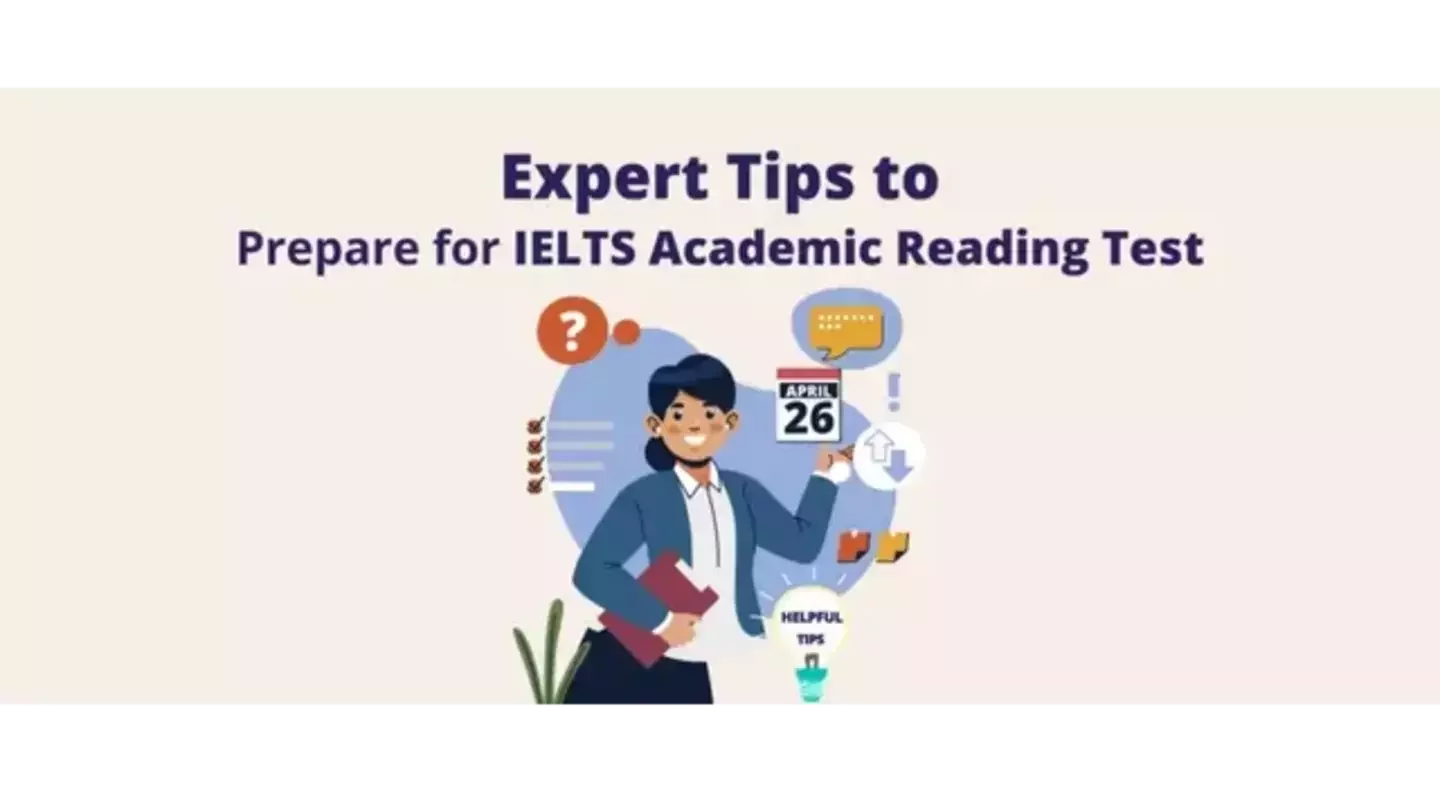Get instant loan offer suitable to your profile !


On this Page:
Confused as to how to go about the IELTS reading section? Well, we have got you covered. Check here IELTS reading study tips, topics, sample questions and books, and so on!

Navigating the IELTS Academic Reading Test requires a strategic approach that combines effective time management, precise reading, and accurate response transfer. By mastering the various question types and implementing the tips shared in this blog, you'll be well-prepared to excel in this crucial segment of the IELTS examination. Just like back in school or college, this test involves the simple yet essential process of reading, finding, and answering.
 Overview of IELTS Academic Reading Test
Overview of IELTS Academic Reading Test
 Scoring and Band Conversion in IELTS Reading Section
Scoring and Band Conversion in IELTS Reading Section
 Technique to Attempt IELTS Reading Section
Technique to Attempt IELTS Reading Section
 Scanning Technique in IELTS Reading Section
Scanning Technique in IELTS Reading Section
 Skimming Technique in IELTS Reading Section
Skimming Technique in IELTS Reading Section
 Choosing the Right Technique
Choosing the Right Technique
 Proven Tips for Success
Proven Tips for Success

The IELTS Reading Test spans 60 minutes, during which test-takers are tasked with answering 40 questions spread across three passages. Similar to the listening test, candidates need to transfer their responses to an answer sheet. However, unlike the listening test, no extra time is allocated for this transfer, making effective time management a critical skill.
The passages in the Academic IELTS Reading Test can span various topics, illustrations, and writing styles. These passages usually run around 800 words and are written at an upper-intermediate (B2) to advanced (C1) level of English. The diversity of topics and styles aims to assess your comprehension skills across a range of contexts.
The IELTS Reading Test presents an array of question types to evaluate your reading abilities comprehensively. You can encounter:
 Multiple Choice Questions
Multiple Choice Questions
 Classification
Classification
 Matching
Matching
 True/False/Not given
True/False/Not given
 Labelling diagrams
Labelling diagrams
 Choosing headings
Choosing headings
 Short-answer questions
Short-answer questions
 Locating information
Locating information
 Sentence completion
Sentence completion
 Identification of the writer's view
Identification of the writer's view
 Notes, table, flowchart completion, and summary
Notes, table, flowchart completion, and summary
Check Your Education Loan Eligibility
Struggling with Your Admissions?

Each correct answer fetches you one point, and there's no negative marking for incorrect responses. With 40 questions in total, you can achieve a maximum score of 40. These points are then translated into band scores based on your performance. Remember, the scoring system for the Reading Test is distinct from that of the Listening test.

The IELTS Reading test is akin to the comprehension exercises we encountered in our school days. It demands finding answers to various question types from a given passage. However, a one-size-fits-all approach doesn't suffice here. Different question types require specific techniques for accurate answers. Enter the heroes of the day: scanning and skimming.
 Scanning: The Robot's Gaze Scanning is your trusty robotic technique. It involves quickly scanning the text to locate specific keywords from the question. This method is ideal for questions that demand specific information. Since you don't read everything word-for-word, scanning saves valuable time. Think of it as a targeted search for the answer needle in the textual haystack.
Scanning: The Robot's Gaze Scanning is your trusty robotic technique. It involves quickly scanning the text to locate specific keywords from the question. This method is ideal for questions that demand specific information. Since you don't read everything word-for-word, scanning saves valuable time. Think of it as a targeted search for the answer needle in the textual haystack.
 Skimming: Embracing the Bird's-Eye View Skimming, on the other hand, takes you to a higher vantage point. With skimming, you rapidly read the entire passage to grasp the overarching message. It's perfect for questions that require understanding the central idea. After skimming, take a moment to reflect. This stage is crucial as it unveils the passage's core essence. Skimming lets you focus on the forest rather than individual trees.
Skimming: Embracing the Bird's-Eye View Skimming, on the other hand, takes you to a higher vantage point. With skimming, you rapidly read the entire passage to grasp the overarching message. It's perfect for questions that require understanding the central idea. After skimming, take a moment to reflect. This stage is crucial as it unveils the passage's core essence. Skimming lets you focus on the forest rather than individual trees.

Scanning, akin to how machines scan, enables you to swiftly locate vital details within a passage, thereby enhancing your chances of securing better scores.
In the IELTS Reading context, time is a precious commodity. With only 60 minutes at your disposal, the need for an efficient strategy becomes evident. Scanning, like a guiding compass, steers you towards the necessary information while helping you bypass superfluous text. Your band scores don't correlate with the volume of content read; rather, they thrive on the accuracy of your answers. Scanning, therefore, becomes an indispensable ally in your quest for higher band scores, streamlining your approach and optimizing your performance.
Let's understand scanning through a step-by-step breakdown, discussed with an actual IELTS Reading question.
Step 1 Grasping the Question: Before embarking on the passage, anchor your focus on the question. Avoid the pitfall of diving into the text without a clear aim. Remember, precision trumps quantity. By scrutinizing the question, you pave the way for an effective scan.
Step 2 Decoding the Question Structure: Dissect the question structure for a holistic understanding. Observe the key components: the objective, instructions, and question statement. Often overlooked, these elements hold the key to accurate responses. Pay heed to word limits for answers, as surpassing them can lead to erroneous marking.
Step 3 Scouring for Synonyms: Begin your scanning process by identifying keywords or their synonyms within the passage. Keep an eye out for subtle variations of the keywords, which Cambridge may employ to test your comprehension. The art lies in spotting these linguistic clues that guide you to the treasure trove of answers.
Step 4 Navigating to the Answer: Once you've tracked down the synonyms, focus on the sentences housing them. By honing in on these specific sentences, you uncover the sought-after information – the answer to the question.
Step 5 Triumphant Revelation: With your scanning efforts honed to perfection, the answer emerges organically. Your attentive scanning, coupled with careful analysis, yields the coveted outcome – a testament to your adeptness at navigating the IELTS Reading terrain.

Skimming, often referred to as reading for gist, allows you to quickly grasp the main idea of a passage. Skimming comes to the rescue by enabling you to extract the essence of a passage swiftly. Its time-saving attributes empower you to navigate through the passages with greater ease and locate answers more efficiently.
The Essence of Skimming
At its core, skimming is about understanding the main idea or central theme of a passage. When confronted with "reading for gist" questions, precision in identifying specific details isn't paramount; grasping the big picture is. Skimming allows you to swiftly glean the primary message of a passage without getting bogged down in intricate details. This technique hones your ability to comprehend a text's overarching message and enhances your overall comprehension skills.
Imagine you're faced with a question that asks you to match paragraphs with suitable headings from a given list. This scenario is a common occurrence in IELTS Reading tests. Here's how you can employ skimming to conquer this challenge:
 Read the Question Statement and Targeted Paragraph: Begin by thoroughly understanding the question at hand. This prevents wasting time on irrelevant sections.
Read the Question Statement and Targeted Paragraph: Begin by thoroughly understanding the question at hand. This prevents wasting time on irrelevant sections.
 Avoid Reading Headings First: While it might seem intuitive to read the headings before diving into the text, it's a common pitfall. Reading all headings can overwhelm you with information, making skimming less effective. Instead, concentrate on the paragraph itself before considering the headings.
Avoid Reading Headings First: While it might seem intuitive to read the headings before diving into the text, it's a common pitfall. Reading all headings can overwhelm you with information, making skimming less effective. Instead, concentrate on the paragraph itself before considering the headings.
 Skim the Paragraph for the Main Idea: Skim through the targeted paragraph, aiming to grasp its central message. Pay less attention to intricate details and unfamiliar vocabulary; the goal is to capture the overall essence.
Skim the Paragraph for the Main Idea: Skim through the targeted paragraph, aiming to grasp its central message. Pay less attention to intricate details and unfamiliar vocabulary; the goal is to capture the overall essence.
 Reflect on the Main Idea: After skimming, pause to recall the main idea in a few words or a sentence. This reflection cements your understanding and prepares you for the next step.
Reflect on the Main Idea: After skimming, pause to recall the main idea in a few words or a sentence. This reflection cements your understanding and prepares you for the next step.
 Match the Main Idea with Headings: Now, turn your attention to the list of headings. Compare each heading with your recollected main idea, ensuring a match. Be vigilant, as there might be extra headings designed to confuse you. Patience and careful consideration are your allies here.
Match the Main Idea with Headings: Now, turn your attention to the list of headings. Compare each heading with your recollected main idea, ensuring a match. Be vigilant, as there might be extra headings designed to confuse you. Patience and careful consideration are your allies here.
 Use a Pencil for Marking: Keep a pencil handy during practice sessions. Circle or mark potential correct responses for future reference.
Use a Pencil for Marking: Keep a pencil handy during practice sessions. Circle or mark potential correct responses for future reference.
 Eliminate and Narrow Down: If you're unsure about a heading, employ the elimination strategy. Cross off headings that don't align with your main idea, refining your choices and increasing your chances of selecting the correct one.
Eliminate and Narrow Down: If you're unsure about a heading, employ the elimination strategy. Cross off headings that don't align with your main idea, refining your choices and increasing your chances of selecting the correct one.
Illustrating Skimming in Action
Let's illustrate this process with an example from a practice test:
You encounter a paragraph discussing a new method of research incorporating real spoken English. Upon skimming, you grasp that the central idea revolves around this innovative research approach. As you peruse the list of headings, the second option, "New method of research," stands out as the perfect match. It aligns seamlessly with the main idea you extracted through skimming.

The million-dollar question is: when to use which technique? The answer lies in the question itself. If the question seeks specific information, opt for scanning. On the contrary, if the question demands the central idea or main point, skimming is your ally. Remember, the techniques aren't mutually exclusive; they can be combined for complex questions.
Let's put theory into practice with a couple of examples
 MCQ - Finding the Main Idea: Question: "In the first paragraph, the writer makes a point that…"
MCQ - Finding the Main Idea: Question: "In the first paragraph, the writer makes a point that…"
For questions like these, where the main idea is sought, skimming is your go-to technique. Rapidly read the paragraph, focusing on grasping the essence. Avoid peeking at the options beforehand, as they might lead you astray. Reflect on what you read and then tackle the options. Choose the one that aligns with your reflection.
 MCQ - Combination Technique: Question: "What does the writer suggest about bringing up baby?"
MCQ - Combination Technique: Question: "What does the writer suggest about bringing up baby?"
This question necessitates a combination of scanning and skimming. Start by scanning for the specific term "bringing up baby" to narrow down the relevant section. Once located, skim that portion to understand the writer's suggestion. Reflect, and then confidently choose the correct option.
Read also:

As you prepare for the IELTS Academic Reading Test, consider these invaluable tips:
 Prioritize Question Understanding: Begin by reading the questions before delving into the passage. This approach directs your focus and guides you in extracting relevant information.
Prioritize Question Understanding: Begin by reading the questions before delving into the passage. This approach directs your focus and guides you in extracting relevant information.
 Efficient Skimming: Avoid reading the entire passage; your goal is to pinpoint correct answers. Skim through the text while keeping the questions in mind.
Efficient Skimming: Avoid reading the entire passage; your goal is to pinpoint correct answers. Skim through the text while keeping the questions in mind.
 Time Management: Allocate around 15-18 minutes per passage, ensuring you answer each question within 45 seconds. Circle challenging questions and revisit them later if needed.
Time Management: Allocate around 15-18 minutes per passage, ensuring you answer each question within 45 seconds. Circle challenging questions and revisit them later if needed.
 Accurate Transfer: When copying answers, pay attention to spelling. Correct answers with wrong spellings don't earn points, so precision is crucial.
Accurate Transfer: When copying answers, pay attention to spelling. Correct answers with wrong spellings don't earn points, so precision is crucial.
Mastering IELTS Academic Reading techniques is a skill that can be honed through practice and understanding. Scanning and skimming are your trusty companions, ready to guide you through the maze of questions. Remember, practice makes perfect, and as you work through various reading tests, you'll become adept at discerning which technique to employ. So, embark on your IELTS journey armed with these powerful techniques.
Happy reading and good luck on your IELTS journey!
Check Your Education Loan Eligibility

Ask from a community of 10K+ peers, alumni and experts
Trending Blogs
Similar Blogs

Network with a community of curious students, just like you
Join our community to make connections, find answers and future roommates.. Join our CommunityCountry-Wise Loans
Best Lenders for Education Loan

ICICI Bank

Axis Bank

Union Bank

Prodigy

Auxilo

Credila

IDFC

InCred

MPower

Avanse

SBI

BOB

Poonawalla

Saraswat